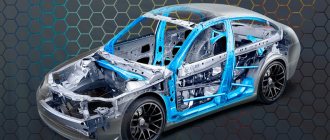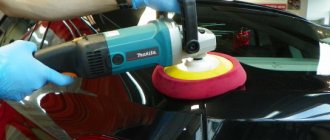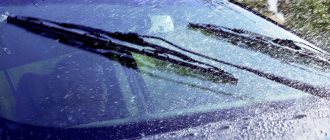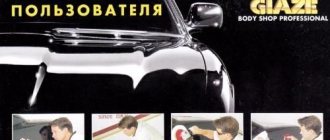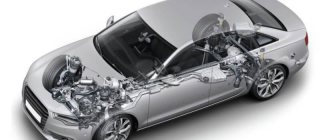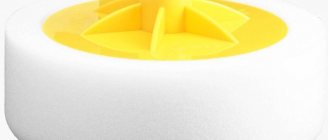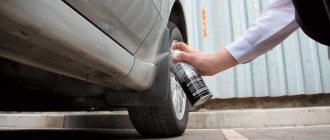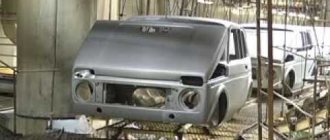Paint protection is one of the main concerns of car owners. Regular contact of enamel with sand, gravel from under the wheels of vehicles ahead, dust and insects significantly affects the appearance of the vehicle. Detailing studio Pasting-PRO offers its clients an inexpensive and elegant way to extend the factory appearance of a car: protective anti-gravel film, ceramics on paintwork or the combined film + ceramics method.
The maximum and most beautiful body protection: polyurethane protective film + ceramics on the film. Mandatory procedure for new cars from the showroom.
Need for use
There is nothing wrong with applying some kind of protective coating to the body. Compositions should be selected based on need, operating conditions and expected effect.
There may be several reasons for applying a coating:
- the car is often driven in poor road conditions;
- it is necessary to disguise minor scratches and update the appearance of the car;
- I want to stand out from the “crowd”;
- I just wanted to take care of the car.
Protective body coatings
Sometimes manufacturers promise an incredible effect after applying one or another coating, but you should not rely on this completely. Silicone-based compounds only cover the body with a thin film and create a glossy effect. The surface becomes smooth, which prevents dust and dirt from accumulating. The coating will not protect against flying stones or direct mechanical impact. To really protect the body, you need to apply more serious compounds, such as ceramics or liquid rubber. Of course, these services are not cheap and are sometimes comparable to the cost of full body painting.
There are many types of coatings, ranging from polishes with various impurities to coatings based on polyurethane and nanoceramics. You should choose based on your needs and capabilities.
The film provides protection against the following factors:
- Gravel, sand and insects flying into the front bumper, radiator, headlights, hood, front fenders, and roof. After a few years, chips can also be found on car doors.
- Careless opening of doors. When the door hits posts, other cars or walls.
- Exposure to chemical reagents in winter.
- Minor scratches from branches and keys.
- Tangent collisions. Minor accidents where parts rub against each other, but do not crush.
- Attempts of vandalism. When a passerby wants to commit lynching or justice and scratch the door with a nail or key.
| An example where film saved paint in an accident |
Anti-gravel coating
Anti-gravel coating is a fairly popular and inexpensive way to protect the car body. It is a film that is applied to the body using heat in special workshop conditions. In turn, anti-gravel coatings are divided into two types:
- polyurethane film;
- vinyl film.
Polyurethane film
Application of polyurethane film
The film is an absolutely transparent coating that protects the body quite well from minor scratches and damage. Of course, you shouldn’t exaggerate its capabilities, but it will cope with dust, dirt and branches. The film is dense and elastic; polish and other compounds can be applied on top of it. Anti-gravel polyurethane film with a thickness of 500-600 microns can protect car optics and the body from stone impacts. The thicker the better the protection.
Vinyl film
In terms of protection, vinyl is much higher than simple film. There are also two types of vinyl covering:
- calendered;
- cast film.
Calendered vinyl film is the most common in use, but is inferior in quality. Hence the lower price. You can choose almost any color you want. The service life is up to a year, then you need to change or remove it.
Cast film is more expensive, but the quality is much higher. Better protects paintwork, masks scratches and chips. Service life from 2 to 5 years. Both types of film are applied by heating with an industrial hair dryer. It should be noted that such work requires skills and experience.
Vinyl film changes car color
The disadvantages include the fact that when dismantling the film can tear off the original paint. It sticks so tightly to the surface. Also, good vinyl is quite expensive.
Pros and cons of surface protection
Precise selection of car hood protection will allow you to fully realize all its strengths and protect the body from damage.
Strengths and weaknesses of deflectors
The undeniable advantage of the deflector is the method of its fastening - on latches that do not require making holes in the hood. High-quality and reliable models are installed using stickers and metal fasteners
When choosing a deflector, special attention is paid to its surface - it must be perfectly smooth, without chips or nicks, otherwise the car body will be hopelessly damaged. The ease and simplicity of both installation and removal of the deflector is another advantage of it, allowing the car owner to remove or replace the part at any time
Liquid rubber
A car treated with liquid rubber
The next way to protect paintwork is to apply liquid rubber. This is a special polymer based on bitumen emulsion, which has excellent hydrophobic and protective properties. The composition is easily applied to the surface by spraying. After hardening, an elastic and fairly durable layer is formed. The body will look more than original. Also, the rubber layer protects the paintwork well from scratches. The service life of liquid rubber is 1.5 - 2 years.
The advantages include the following:
- quickly and easily applied to almost any surface;
- pleasant to look and feel;
- cheaper in cost compared to vinyl;
- good protective qualities;
- the coating is easy to remove if necessary;
- many colors to choose from.
There are not many disadvantages, but they are:
- quite easy to damage or tear off;
- cheap compounds may crack.
Plastic deflectors
There are two types of this protection: hood deflector and side window deflector - wind deflectors. Deflectors protect against the ingress of small gravel and stones, which later contribute to the formation of dents and rust.
Plastic deflectors are much thicker than liquid coatings applied to the surface of a car. They look like car trims and are made of plastic or durable acrylic glass.
To install such a deflector, it is necessary to remove the protective film from it. Remove the protective caps of the fasteners and slightly stretch the bolts for subsequent installation on the hood. On an open hood, place the deflector in the center of the hood and secure the deflector fasteners under the rubber band of the car.
After which the deflector fasteners are tightened tightly. During installation, the fasteners should be pressed as close to the hood as possible so that the deflector does not hit the grille.
The active action of the deflector begins at speeds of 70 km/h. When the deflector artificially creates an air flow that prevents the accumulation of dirt on the hood.
There is also a small drawback of this product: aerodynamics with a deflector decreases, which affects the increase in fuel consumption.
Liquid glass
Liquid glass is a silicate solution that is applied to the car body. After application, the solution dries and crystallizes, leaving a mirror effect. It looks beautiful, but is ineffective as a real protective agent. The composition makes the surface smooth and shiny, which prevents dust from accumulating, which means you can visit the sink less often. This is where the protective properties end. With careful care, liquid glass will last up to 1 year. The price is quite reasonable.
“Before” and “After” treatment with liquid glass
It is very easy to apply using a sponge. Just before work you need to thoroughly wash and degrease the surface. Then let the composition dry for 1-3 hours.
Anti-gravel
The choice of those who are worried about the condition of the sills and wheel arches. These body parts most often suffer from reagents, aggressive environments and sudden temperature changes. Any chipping in such areas can cause corrosion to develop in a matter of weeks. Therefore, knowledgeable people apply anti-gravel to the most unprotected areas of cars. There is only one drawback - it is good for local areas; it cannot be applied to the entire body.
At the same time, high-quality anti-gravel must have good wear resistance to withstand impacts, and elasticity so as not to crack. For example, the Russian composition from Astrohim performed well. The coating perfectly resists abrasive wear and does not peel off from the surface. This anti-gravel agent is available in the form of an aerosol and no additional equipment is required for its application.
Ceramic
The composition of ceramic coatings is based on silicon dioxide and titanium oxide. It is considered more durable and durable compared to liquid glass. Well protects paintwork from corrosion, large abrasive particles, and aggressive chemicals. After application, the surface becomes glossy and shiny. The car looks presentable.
Ceramics are applied in several stages, forming up to 10 layers. You need to maintain a certain temperature when working. Drying lasts up to 8 hours, after which you cannot go to the car wash for at least two weeks. The coating lasts up to two years, although manufacturers promise a very long service life. The cost varies from 13,000 to 20,000 rubles, depending on the area and quality of materials.
Damage and chips
As the vehicle is used, various damage to the protective paint coating may appear on its body:
Minor scratches on the top layer of the coating that do not affect the base layer. They can be eliminated by polishing the body with polish, pencil or wax. Minor damage to the body, which can be removed by polishing. Medium-depth scratches on the top layer. They are removed by painting the damaged area. Damage that is eliminated by painting the area. Scratches down to the ground layer. With a pencil you can remove only those of them that are not very wide. The remaining damage is either painted in two layers or eliminated locally with restoration of the body geometry. Defects that can be eliminated by painting in several layers. Scratches that reach the metal of the body. They are eliminated by priming the damaged area and then painting it in three layers. The primer is applied very thinly so that the area does not stand out. Removed by priming and painting the damaged areas. Scratches on the surface of the bumper. Such defects are painted over with a repair balloon. Paint over with a repair can of paint. Scratches that have caused rust and corrosion. The damaged area is cleaned of paint and primer using special means, after which it is re-primed and painted. The most complex defects can be eliminated using special anti-corrosion compounds. If the defect affects the metal, then it is painted over, if only a primer, then it is polished. Chips of paint on the hood of a car, which can be removed by painting or polishing. Bubbles of paint. They are removed by painting the area in several layers and polishing it. Bubbles in body paint that can be removed by polishing or repainting
Polymer coating "Raptor"
Raptor is a polyurea or polyurea elastomer that has increased strength. After application, a durable insulating coating is formed on the surface of the body. In fact, applying a raptor can be compared to painting a body.
This composition is most often used to protect car bodies that are operated in particularly aggressive conditions. A real armor is formed that protects against mechanical damage, environmental influences, and ultraviolet radiation.
Before applying the composition, as with standard painting, the body is thoroughly washed and degreased. Then the composition is applied with a pistol.
Covering “Raptor”
The Raptor is sold in only two colors:
- black;
- white
To obtain other shades, a colorant is required. After drying, a matte surface with a specific roughness is formed. The composition dries in 8-10 hours, complete hardening occurs in 2-3 weeks.
Advantages of the Raptor coating:
- perfectly protects the body from various influences;
- increases sound insulation;
- protects against corrosion;
- looks “brutal”;
- acceptable price.
Minuses:
- a matte surface with roughness remains;
- takes a long time to gain strength (3 weeks);
- quite difficult to remove.
Body treatment with polyurea
The modern market offers various methods of protecting the surface of a car, but one of the most effective is a body product called polyurea. It has many advantages, such as elasticity, chemical resistance, and strength. This material also has an impressive service life of more than 50 years. From this we can conclude that the body is treated with urea not for a while, but for many years.
This product is a liquid composition of two components, which hardens extremely quickly. To coat a car with polyurea, special equipment is used to mix the ingredients and then spray them. This is easy to do, so vehicle owners can save their time and effort.
Another advantage of coating a car with polyurea is its resistance to temperature changes. This is useful, given that in some areas of the body the temperature can vary greatly. Also, a machine treated with polyurea will be immune to dynamic loads, which avoids deformation. The car's coating will be reliably protected from corrosion, scratches and other similar defects.
Protective polishing
The most common and affordable coating. There are quite a lot of different polishes. The composition is applied with a rotary machine, filling small cracks and forming a smooth and shiny surface. After polishing the car looks great.
Polishing, of course, is not suitable as protection against serious damage and scratches. Wax-based polishes have hydrophobic properties, but nothing more. On a smooth surface, less dirt accumulates. The first wash will wash off the composition and must be reapplied. Fortunately, the price is quite reasonable, so this service is often offered directly at car washes.
The advantage of polishing is its brilliant effect and affordable price. The downside is that there is no serious protection.
Why do you need to protect your car hood?
The technical condition of the car is the first and practically the main thing that its owner pays attention to and maintains during operation. Few people take sufficient care of the exterior of the car, including its body, although it is one of the most vulnerable elements
Over the entire period of operation, the surface of the car is subject to various destructive influences, which lead to the formation of chips, scratches, cracks and other defects. They can cause much more serious consequences - corrosion, which over time will destroy the metal of the body. The most vulnerable places are the bumper and the hood: it is they who collide while driving with stones, sand and other objects that fly out from under the wheels of the vehicle in front and cause damage.
conclusions
As you can see, there are a lot of ways to protect the body of your car. A few more can be added to this list, but they differ not much. The question arises, which method is the most effective? The correct answer will be based on needs. If you need really serious protection from stones and scratches, then you need to choose coatings like “Raptor”, liquid rubber or thick anti-gravel film, but they give a specific appearance. If you need to update the body, make it bright and shiny, prepare the car for sale, or disguise minor scratches, then polishing or Teflon coating is suitable. Slightly more serious protection is provided by vinyl coating, polyurethane films and liquid glass.
Ceramics for paint or film provides:
- Extending the service life of paintwork or film.
- Improved appearance: glossy finishes are more shiny, while matte finishes have an amazing depth of color.
- Protection from reagents and acid rain.
- Protection from ultraviolet rays.
- Increase the hydrophobic effect.
Ceramics is a kind of coating of a car with a thin, transparent shell.
At the same time, we use ceramics from market leaders with a hardness of at least 9H. What is hardness 9H - this is the Wolf-Wyborn method for determining the hardness of a surface by scratching it with pencils. Read more. We show an example of a body coated with ceramics: amazing shine and a powerful hydrophobic effect.
Useful tips
Finally, we will give some useful tips on how to properly use body protection products. This will allow you to protect your car with the highest quality and reliability.
- Always apply protection only to a clean and dry car. It is best to do this after washing. Some automatic car washes allow you to apply wax or other liquid compounds. This nuance needs to be clarified with the car wash staff.
- If there are chips and scratches on the car, before using ceramic spraying, it is better to remove them in advance.
- Some products involve the use of rags to distribute the composition. It is better to use microfiber cloths. They do not leave fibers.
- Before applying, carefully read the instructions for the drug. This will allow you to accurately calculate the amount of substance. If you apply little protective substance, it will be of no use; it is better to apply more layer and remove the excess. Just without fanaticism.
